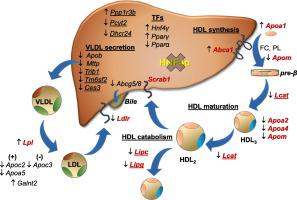Metabolism ( IF 10.8 ) Pub Date : 2020-07-03 , DOI: 10.1016/j.metabol.2020.154307 Efstathia Thymiakou 1 , Alaa Othman 2 , Thorsten Hornemann 2 , Dimitris Kardassis 1

|
Background
Aberrant concentration, structure and functionality of High Density Lipoprotein (HDL) are associated with many prevalent diseases, including cardiovascular disease and non-alcoholic fatty liver disease (NAFLD). Mice with liver-specific ablation of Hnf4α (H4LivKO) present steatosis and dyslipidemia by mechanisms that are not completely understood. The aim of this study was to explore the role of liver HNF4A in HDL metabolism and the development of steatosis.
Methods and results
Serum and tissue samples were obtained from 6-weeks old H4LivKO mice and their littermate controls. Liver and serum lipids were measured and HDL structure and functionality were assessed. Global gene expression changes in the liver were analyzed by expression arrays, validations were performed by RT-qPCR and DNA-protein interactions were studied by chromatin immunoprecipitation (ChIP). H4LivKO mice presented liver steatosis, increased liver triglyceride content and decreased concentration of serum total cholesterol, HDL cholesterol, triglycerides, phospholipids and cholesteryl esters. Most classes of phospholipids showed significant changes in species ratio and sphingosine-1-phosphate (S1P) levels were reduced. H4LivKO serum was enriched in the smaller, denser HDL particles, devoid of APOA2 and APOM apolipoproteins, exhibiting decreased activity of paraoxonase-1 but retaining macrophage cholesterol efflux capacity and phospho-AKT activation in endothelial cells. Global gene expression analysis revealed the association of liver HNF4A with known and novel regulators of HDL metabolism as well as NAFLD-susceptibility genes.
Conclusions
HNF4A ablation in mouse liver causes hepatic steatosis, perturbations in HDL structure and function and significant global changes in gene expression. This study reveals new targets of HNF4A involved in HDL metabolism and the development of steatosis and enriches our knowledge on HDL functionality in NAFLD.
中文翻译:

肝细胞核因子4A肝脏特异性切除的小鼠高密度脂蛋白代谢和肝脂肪变性的缺陷。
背景
高密度脂蛋白(HDL)的异常浓度,结构和功能与许多流行疾病相关,包括心血管疾病和非酒精性脂肪肝疾病(NAFLD)。肝特异性切除Hnf4α(H4LivKO)的小鼠表现出脂肪变性和血脂异常,其机制尚不完全清楚。这项研究的目的是探讨肝脏HNF4A在HDL代谢和脂肪变性发展中的作用。
方法与结果
从6周龄的H4LivKO小鼠及其同窝对照中获得血清和组织样品。测量肝脏和血清脂质,评估HDL结构和功能。通过表达阵列分析肝脏中的整体基因表达变化,通过RT-qPCR进行验证,并通过染色质免疫沉淀(ChIP)研究DNA-蛋白质相互作用。H4LivKO小鼠表现出肝脏脂肪变性,肝脏甘油三酸酯含量增加和血清总胆固醇,HDL胆固醇,甘油三酸酯,磷脂和胆固醇酯浓度降低。大多数类别的磷脂显示出物种比率的显着变化,并且鞘氨醇-1-磷酸(S1P)水平降低。H4LivKO血清富含较小,较密的HDL颗粒,不含APOA2和APOM载脂蛋白,表现出降低的对氧磷酶-1的活性,但保留了内皮细胞中巨噬细胞的胆固醇外排能力和磷酸化AKT活化。全局基因表达分析揭示了肝脏HNF4A与HDL代谢以及NAFLD敏感性基因的已知和新型调节剂的关联。
结论
小鼠肝脏中的HNF4A切除会引起肝脂肪变性,HDL结构和功能紊乱以及基因表达的显着整体变化。这项研究揭示了参与HDL代谢和脂肪变性发展的HNF4A的新靶标,并丰富了我们对NAFLD中HDL功能的认识。











































 京公网安备 11010802027423号
京公网安备 11010802027423号